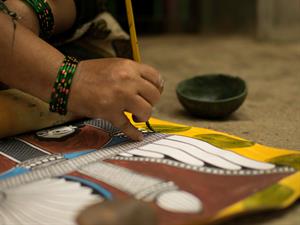PDF chapter test TRY NOW
Over time, however, people lost interest in this art form and there were few artists and fewer listeners. To keep their art alive in the modern world, the patuas adapted their skills and themes to the times. An innovative step they took to do this was to establish a patachitra village at Naya. Slowly, the efforts to revive their artistic heritage started paying off. Today, the patachitra art is flourishing again in the village, with village youngsters taking up the traditional art form as a passion and profession.
A traditional pata was painted on a canvas made of jute fibre. Now, it is made by stitching together sheets of commercial poster paper. The colours come from plants such as marigold, indigo, teak leaves, saffron, and turmeric. They also use lamp black. The colours are mixed in coconut shells with the sap of the bel tree (wood apple), which acts as a glue. After finishing, a thin cotton cloth is glued to the back of the painting so that it will last long. Next, the completed scrolls are dried in the sun before they are stored in rolled up bundles.
Explanation:
As days passed, people started losing interest in this art. Since there were not many viewers, the number of artists also started deteriorating. So they decided to modernize the art form. The artists adopted new themes and applied skills according to the changing times. The first step they took to achieve their goal was to establish a village called "Naya".
Pata (or pictures) were painted on a canvas made of jute fibre material. Thick sheets of poster paper (used for commercial purposes) are stitched together to make rolls. They use natural colours taken from plants such as marigold, indigo, teak leaves, saffron and turmeric. Interestingly, they also use the black flaky substance that arises from fire smoke, called lampblack. The colours are mixed in coconut shells with the gum, called sap - obtained from the bel or wood apple tree.

*A patua displaying the colours mixed in coconut shell!
The fluid acts as the glue in the process. Finally, a cotton cloth is stuck behind the painting so that the images holds well for a long time. The completed scroll paintings are dried in the sun and then rolled up into bundles and stored for future use.

Pictorial presentation of the art process!
Meanings of difficult words:
No. | Words | Meaning |
1 | lampblack | a black pigment made from black powder which rises in the smoke from a fire |
2 | sap | the fluid which circulates in a plant, consisting of water with dissolved sugars and mineral salts |
Reference:
State Council of Educational Research and Training (2019). Term-2 English Standard-7. Naya - The Home of the Chitrakaars (pp. 126-131). Published by the Tamil Nadu Textbook and Educational Services Corporation.
*Image courtesy: Rudra Narayan Mitra / Shutterstock.com
